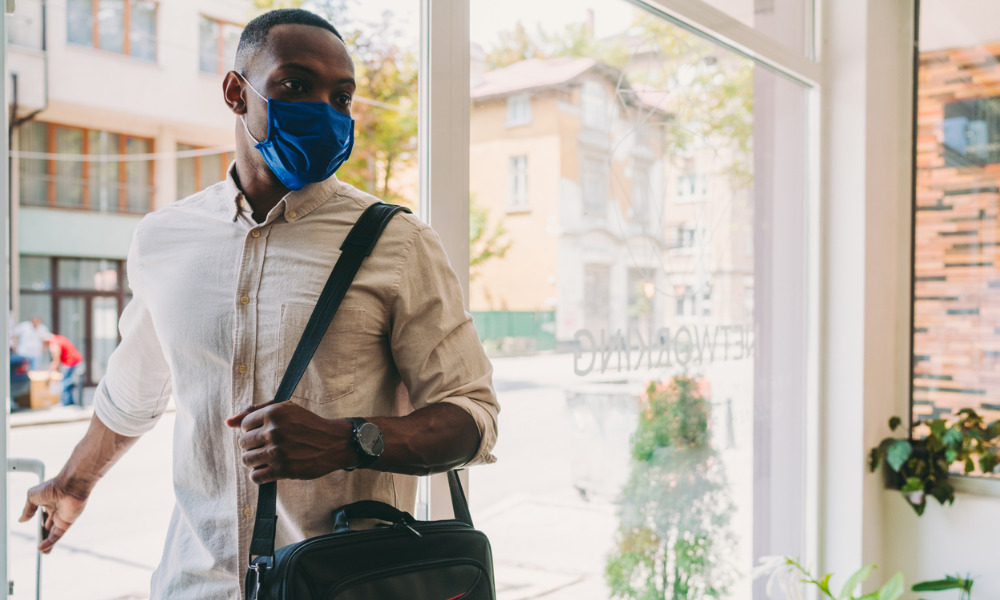Survey says 40 per cent are keen to return – but anxiety is an issue

An average of 40 per cent of employees currently teleworking wants to return to the workplace.
So say Canadian decision-makers in responding to a survey about working amid the pandemic.
Close to four in 10 (37 per cent) of the respondents say they expect all their employees to return to working at their physical location rather than working remotely in the first half of 2021.
That compares to 27 per cent for the fall of this year and 13 per cent for the second half of 2021.
Close to eight in 10 (79 per cent) say that flexible working (sometimes from the office, sometimes from home) will be a permanent change at their company, found the survey released by Get Working, a product by software company Foko Retail.
"We know businesses will transition to flexible working permanently and that the use of workspace needs to be properly documented for contact tracing purposes. We also know there is a need to remotely test employees before they even enter the office,” says Gingras. “The question is how do companies manage capacity, contact tracing, and health and safety in a meaningful way that supports the needs of workers and employers alike."
Fifty per cent of decision-makers think their company will not be downsizing but will change the type of space they have in the next two years. For the 22 per cent who think their company will downsize its space, it’s estimated they’d looking to reduce space by an average of 34 per cent.
Asked if they are planning to limit the number of employees who can come to the office, 68 per cent report yes, immediately, while 19 per cent report yes, in the future, and 13 per cent report they have no plan to do so/it’s not necessary.
Anxiety issues around safety
However, 79 per cent of respondents say that they sense anxiety among their team around coming back to the workplace in-person.
Matching the sentiments of many Canadians, employees in the U.S. and U.K. have strong concerns about returning to the workplace, citing safety risks amid the pandemic.
And half of the decisionmakers say that they are finding it awkward to communicate with their team about the return to the office, finds the Get Working survey of 435 decision-makers in Canadian companies between Aug. 4 and Aug. 12, 2020.
In rating a number of potential safety procedures on their level of difficulty to implement, enforcing social distancing (6.3 out of 10) and convincing employees it’s safe to return to work (6.2 out of 10) came out on top.
The biggest concern about having employees return is ensuring the safety of the working environment and that proper safety procedures are in place (22 per cent), followed by possible exposure/bringing COVID-19 into the workplace (21 per cent) and maintaining social distancing (17 per cent), finds Get Working.
Two thirds of decision-makers (66 per cent) say they are planning to immediately require all people to wear masks at all times in the workplace, while 19 per cent say they have no plan to do so/it’s not necessary, and 15 per cent say yes, in the future.
Just under six in ten decision-makers (59 per cent) say they are planning to immediately stop sharing tools such as computers and machines among employees, while 23 per cent report yes, in the future, and 18 per cent report they have no plan to do so/it’s not necessary.
One in five (20 per cent) of COVID-19 infections among working-age adults in Ontario can be attributed to workplace transmission, according to data from the Institute for Work & Health (IWH) released earlier this month.
Mitigating the risks
Employers can mitigate the risk of spreading COVID-19 in the workplace by doing the following, according to the federal government:
- Discourage people who are ill from entering the workplace or business.
- Promote and facilitate personal preventive practices.
- Promote physical distancing.
- Create physical barriers between employees or clients when physical distancing is not possible.
- Increase ventilation.
- Mitigate risks from exposure to high-touch surfaces
- Mitigate risk for people at higher risk of severe illness.
- Modify practices to reduce how long employees or clients are in contact with each other and how many employees/clients come into contact with each other.




